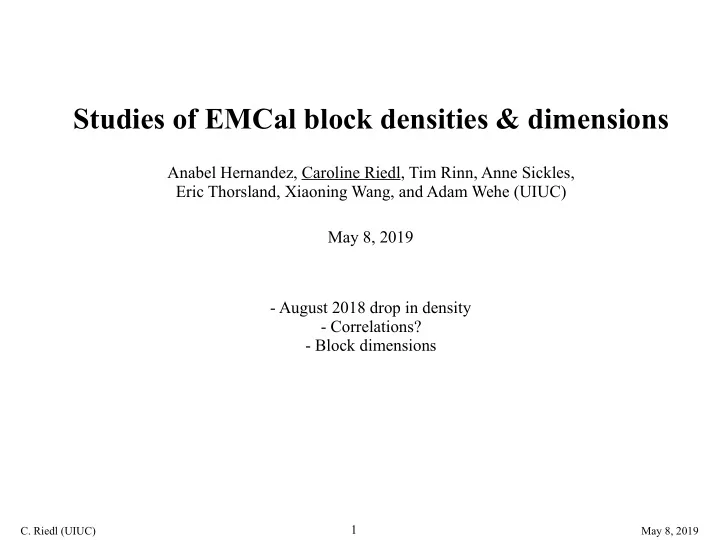

Studies of EMCal block densities & dimensions Anabel Hernandez, Caroline Riedl, Tim Rinn, Anne Sickles, Eric Thorsland, Xiaoning Wang, and Adam Wehe (UIUC) May 8, 2019 - August 2018 drop in density - Correlations? - Block dimensions 1 C. Riedl (UIUC) May 8, 2019
Block density vs. time Block Density Sector 0 Block Density Sector 1-12 Avg block density [g/cm3] THP Sector 0 Avg block density [g/cm3] THP Sector 1-12 Avg block density [g/cm3] HCS Sector 0 Avg block density [g/cm3] HCS Sector 1-12 0.85* Avg tap density THP [g/cm3] S0 0.85* Avg tap density HCS [g/cm3] S0 10.0 10.0 9.5 9.5 9.0 9.0 8.5 8.5 9/1/2018 11/1/2018 1/1/2019 3/1/2019 4/5/2019 4/7/2019 4/9/2019 4/11/2019 4/13/2019 4/15/2019 W date sorted W date sorted • Left: drop in THP block density in October 2018 (blue curve), while tap density stayed ~ constant • Recovering towards the end of March? (also slightly higher tap density due to different buckets) • HCS block density was higher in 2018 than in 2019 using very similar tungsten batches • Right: overall HCS block density is lower, as ~ expected from lower HCS tap density 2 C. Riedl (UIUC) May 8, 2019
Twin blocks March 2019: THP vs. HCS • Lower tap density of HCS as compared to THP considered to be the main reason for the overall lower density of HCS blocks. • Set of twin blocks potted in March side-by-side using - block 9, DBN 353 THP - block 9, DBN 354 HCS In both cases, no more powder could have been added: both blocks were filled up to the top edge of the mold windows. • Ratio of block densities HCS / THP = 0.91 • Ratio of tap densities HCS / THP = 0.93 • Difference in these ratios is attributed to the fact that the final block compound also contains materials of lower density than tungsten (fibers, brass and epoxy). 3 C. Riedl (UIUC) May 8, 2019
What drives the block density? Block Density Sector 0 Avg block density [g/cm3] THP Sector 0 • The more tungsten weight is Avg block density [g/cm3] HCS Sector 0 filled, the higher the block 0.85* Avg tap density THP [g/cm3] S0 density (in general) 10.0 • Relative weight = actual filled 9.5 mass [g] / average mass [g] for that block design of S0 9.0 Block density vs. relative tungsten weight (S0) 8.5 9/1/2018 11/1/2018 1/1/2019 3/1/2019 10.00 W date sorted Avg relative filled W weight vs. W date (Sector 0) 9.50 1.05 Avg relative tungsten weight block density [g/cm3] 1.025 9.00 1 0.975 8.50 0.95 9/1/2018 11/1/2018 1/1/2019 3/1/2019 8.00 0.85 0.9 0.95 1 1.05 1.1 1.15 W date sorted Relative tungsten weight 4 C. Riedl (UIUC) May 8, 2019
Why does the block density drop? (I) Block Density Sector 0 Avg block density [g/cm3] THP Sector 0 Avg block density [g/cm3] HCS Sector 0 0.85* Avg tap density THP [g/cm3] S0 • Block density not 1:1 related to 10.0 tap density • Do different W fillers 9.5 compactify differently? Not really. Drop affects them all. 9.0 8.5 Tap density S0 vs. Block density S0 9/1/2018 11/1/2018 1/1/2019 3/1/2019 W date sorted 11.4 Block Density Sector 0 10.00 Avg block density [g/cm3] THP Sector 0 9.75 Avg block density [g/cm3] 11.2 HCS Sector 0 tap density S0 9.50 0.85* Avg tap density THP [g/cm3] S0 9.25 avg. ET 11.0 9.00 avg. SA avg. MA 8.75 7/5/2018 7/6/2018 7/9/2018 7/10/2018 7/13/2018 8/2/2018 8/6/2018 8/22/2018 8/30/2018 9/26/2018 10/8/2018 11/19/201 2/14/2019 2/18/2019 2/21/2019 2/25/2019 3/1/2019 3/5/2019 3/7/2019 3/14/2019 3/25/2019 3/27/2019 3/28/2019 avg. SS 10.8 8.50 8.75 9.00 9.25 9.50 9.75 Block density S0 5 C. Riedl (UIUC) May 8, 2019
Block density vs. time and block count Block Density Sector 0 Avg block density [g/cm3] THP Sector 0 Avg block density [g/cm3] HCS Sector 0 0.85* Avg tap density THP [g/cm3] S0 10.0 9.5 9.0 8.5 9/1/2018 11/1/2018 1/1/2019 3/1/2019 Sector 0: block count vs. time W date sorted count THP count HCS 20 15 • At the time of the 10 drop, many blocks were potted 5 0 7/5/2018 7/6/2018 7/9/2018 7/10/201 7/13/201 8/2/2018 8/6/2018 8/22/201 8/30/201 9/26/201 10/8/201 11/19/20 2/14/201 2/18/201 2/21/201 2/25/201 3/1/2019 3/5/2019 3/7/2019 3/14/201 3/25/201 3/27/201 3/28/201 W date sorted 6 C. Riedl (UIUC) May 8, 2019
Why does the block density drop? (II) Block Density Sector 0 • Avg block density [g/cm3] THP Sector 0 Drop is Avg block density [g/cm3] HCS Sector 0 between early 0.85* Avg tap density THP [g/cm3] S0 October and 10.0 mid March • 9.5 Environment? • It is warm and 9.0 humid in the high-bay area 8.5 where the W is 9/1/2018 11/1/2018 1/1/2019 3/1/2019 stored, cool Avg temperature [F] per hour W date sorted and dry in heat ON in high bay summer • Does the ambient humidity affect the block density? • So far best guess… 7 C. Riedl (UIUC) May 8, 2019
Why does the block density drop? (III) • Big shaker table introduced in December 2018, cannot explain drop in block densities • Different levels and methods of densification are being tested, no conclusive results yet • The shorter the epoxy pulling out time, the higher the block density - with outliers. 8 C. Riedl (UIUC) May 8, 2019
Quality of blocks potted with HCS in 2019 and undersized blocks • All Sector 1 blocks produced with HCS in 2019 (so far ~20) need touch-ups after they come out of the mold, longer epoxy time. • Potting procedure had been optimized for THP in 2018. • All blocks come out slightly undersized. This had already been the case for THP in 2018/2019 (table), which is attributed to (intentionally) undersized molds. • However HCS blocks shrink more than THP blocks, which is why the undersizing effect is pronounced more in HCS. 9 C. Riedl (UIUC) May 8, 2019
Blocks potted with HCS in 2019 10 C. Riedl (UIUC) May 8, 2019
Recommend
More recommend